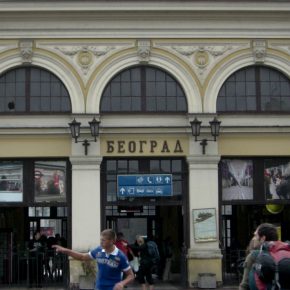Tydzień w gospodarce
Category: Trendy gospodarcze

Train station, Belgrade, Serbia (kinou, CC BY-NC-ND)
Huawei said it wants to offer its technologies, knowledge and experience acquired during similar projects in Europe, following a meeting between Huawei’s president for CEE, David Tang, and Serbian transport minister Zorana Mihajlovic. The Senvion investment include delivery, installation and commissioning of 21 turbines for the Alibunar wind farm in Serbia, SeeNews reported.
Mihajlovic said that the reform of the railways is a priority project for Serbia, and added that a deal to finance the upgrade of the Belgrade-Budapest railway line should be signed at the forthcoming 16+1 Summit in Riga, Latvia on November 5th. The 16+1 format is an initiative of China aimed at intensifying and expanding cooperation with 11 EU Member States and five Balkan countries in the fields of investments, transport, finance, science, education, and culture.
Hungary, China and Serbia had signed an intergovernmental agreement on the refurbishment of the Budapest-Belgrade railway line in 2015. The project with an estimated cost of EUR1.5bn would be 85 per cent financed with the proceeds of a Chinese loan, the Hungarian government said at the time.
In 2013, Serbian state-owned railway operator Zeleznice Srbije signed a framework pact with Huawei which planned to invest EUR22m in the company’s telecommunications infrastructure in 2014. The planned investments were to include the construction of fiber-optic and copper cable networks, deployment of transmission and switching systems, information systems, new railway equipment, local radio networks and a radio dispatch system.
In another landmark deal, a fixed network transformation project has been launched between Huawei and Serbia’s national operator Telekom Srbija, marking the start of the first large-scale cooperation in the information and communication technology between China and Serbia. The aim of this project is to modernize the existing fixed network of Telekom Serbia, to improve its service and provide users with a much faster network with various performances, high quality video, as well as introduce smart home solutions, the company said. Telekom will invest EUR150m in the area of fixed Internet and multimedia, which will include more than a million homes and objects in numerous cities and significantly increase Internet speed. Telekom Srbija is Serbia’s biggest fixed network operator with 70 per cent of fixed network users.
In June China strengthened its economic presence in the Central and Southeast Europe by signing 22 agreements on finance and infrastructure with Serbia, from currency swaps, renewable energy and highway construction. Beijing sees it as part of its One Belt, One Road initiative, which is intended to open new foreign trade links for Chinese firms as its own economy slows.
China has already invested more than EUR1bn, mostly in the form of soft loans, to finance road building and energy projects in Serbia.
In April, China’s Hebei Iron & Steel (HESTEEL) signed a EUR46m deal to buy a steel plant located on the Danube, an investment which analysts said opened door for Chinese investment in Serbia’s ailing metals sector.
„China and Serbia are traditionally friendly nations. Our intention is to raise our strategic partnership to a higher level,” Xi said, adding that the two countries agreed that their presidents should meet once a year to discuss ways to work together including „military cooperation.”
Serbia’s energy minister signed a deal to finance renewable energy sources and to build Serbia’s first waste-to-energy plant as it seeks to replace its aging coal-fired power plants to meet green energy targets.
Serbia – a member of the European Energy Community and a candidate for joining the EU – has committed to renewable energy targets in its action plan for energy. It is aiming for 500 MW of wind capacity by 2020.
The Senvion installation is planned to take place in autumn 2018 close to the Malibunar wind farm, where Senvion already closed another conditional deal with the customer over four Senvion MM100 turbines. „The Alibunar and Malibunar projects mark the successful market entry into Serbia for us but also show the flexibility of Senvion to deliver turbines to every location and market,” said Jochen Magerfleisch, Senvion’s executive vice president for sales in Europe.
For both projects, Senvion will take care of servicing over a period of 15 years. Senvion worked with Elicio NV previously on two projects in France and Belgium.
The Alibunar wind farm will be located in the village of the same name 60 kilometers north of Belgrade. The 21 turbines with a hub height of 100 meters and rated output of two megawatts (MW) each will together produce enough energy to power around 27,600 households on average per year.
In November 2015, Serbia became a wind producer with the official start to operations of the 9.9 MW Kula wind farm in the province of Vojvodina, in the north of the country, developed by MK Fintel Wind, a joint venture that is 54 per cent controlled by Italy’s Fintel Energia Group and 46 per cent by Serbian conglomerate MK Group. MK Fintel Wind said it invested about EUR15m in the project, which comprises three Vestas V117 3.3MW turbines.
MK Fintel Wind is now constructing a second wind farm in Serbia – the 6.6 MW La Piccolina project in Vrsac, also located in Vojvodina province – and expects to commission this in 2016.
Green Star Alternative Energy has been constructing the first wind farm in Serbia through its Belo Blato Wind Energy Project. The project is divided into 2 phases. The first phase includes a 20 MW wind farm which began operating in 2009. The second phase includes development of additional 300-MW of wind generated power.
The quota includes projects Čibuk 1 by Vetroelektrane Balkana d.o.o. (Continental Winds) of 158.4 MW, Kovačica by Elektrawinds K-Wind d.o.o. of 105.6 MW, and Plandište 1 by Wind park Plandište d.o.o. of 102 MW. The last one is controlled by NIS, Serbia’s flagship oil and gas company, majority owned by Russian Gazprom Neft.
Elicio had facilities Alibunar and Malibunar of 42 MW and 8 MW, respectively, accepted within the designated volume through firms Electrawinds-S d.o.o. and Electrawinds Mali WF d.o.o.
Meanwhile, three projects managed by venture MK-Fintel Wind a. d. in the list are Košava, with 68 MW, La Piccolina, 6.6 MW, and Kula, the only operational wind farm, of 9.9 MW. However, only 22.6 MW of Košava was included in the quota, while Ram, facility planned for 9 MW, was rejected.

